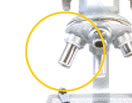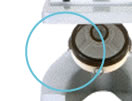|
|
|
 |
 |
 |
 |
 |
Jong Min Sung
Applied Physics
Bio-X
Graduate Student Fellowships 2009/2010
Professor James Spudich (Biochemistry)
The objective of Jong’s research is to obtain a precise correlation between the mechanical, structural and biochemical aspects of actomyosin interactions associated with human beta-cardiac myosin cardiomyopathies at a single molecule level. The Spudich lab’s hypothesis is that the structural changes caused by the mutations will cause malfunctions of beta-cardiac myosin, in terms of 1) force generation roles (step size, force), 2) enzymatic roles (actin-activated ATPase), and 3) coordination between them. To clarify with molecular precision which aspects of chemo-mechanical transduction are altered by selected HCM familial mutations, we will directly measure individual actomyosin interactions using a variety of single molecule tools. |
 |
|
 |
|
|










